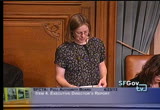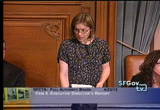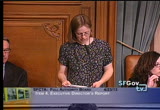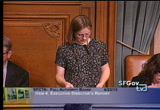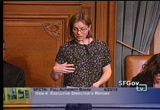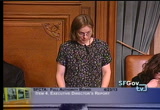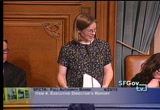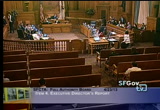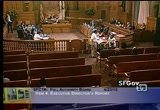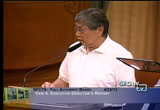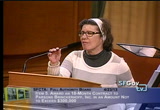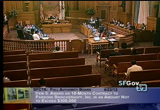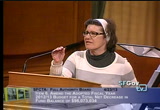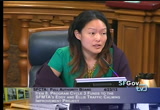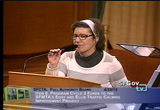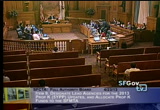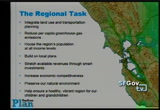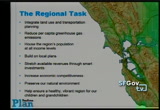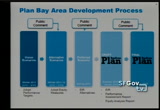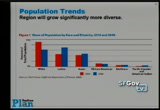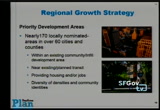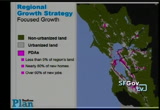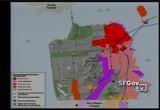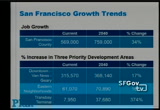tv [untitled] April 24, 2013 1:00am-1:30am PDT
1:00 am
transit expansion projects unfortunately it relies on a peace dividend from the wars in iraq and afghanistan, and we feel that it has no chance of passage, given the lack of appetite to identify a new source for transportation as well as everyone beginning to realize the impact of sequestration. the one great spot is the tiger program generating economic program and that has managed to survive. it is over 350 million available minimum size is 10 million, in the past for san francisco this has funded a part of the parkway and transportation improvements in the mission bay area, san francisco tends to do well and according with the mayor's office and what the priorities will be for the fifth cycle and
1:01 am
another budget-related document at the state level that the california air resources board and the department of finance released the first investment plan for auction from the cap and trade auction and this is there was also 8032 and this is one of the ways in which the state hopes to reduce greenhouse gas levels as we reported previously, the proceeds fall significantly below of what the governor had anticipated in the budget which is about a million dollars, the two auctions have brought in a half a billion and there is good news, in the investment plans, that has come out, and well it does not name specific project and link them to specific dollar amounts it does say that the largest share of funding should go to sustainable communities and clean projects including rail modernization and high speed rail programs and transit oriented development we will keep an eye on this and report back to the finance committee next month, this plan will be
1:02 am
presented to the legislature on april the 25th. for the parkway, it continues to move a pace within a couple of important milestones in terms of notice to proceed in the last couple of months, in late march, the link, the concessionaire for the project assumed operation and maintenance while the people may not realize that they are maintaining even one of the facilities that was built by cal trans and operating and maintaining phase two once that is built. and now phase two construction is under way and so the stuff going on above and below ground and you can see it as well as the work to stabilize the soils in order to build the tunnels we have a lot of information and photos on the website, www.precidio parkway.org. >> the park stationary circulation study has finished the effort to collect the data on existing conditions and work with the other stake holders
1:03 am
and come up with a number of alternatives to deal with the configurations with the i280 ramps the kiss and ride and drop off and these were shared with the advisory committee on march 13th and there will be a wider public out reach effort coming this summer, (inaudible) transit made some significant progress on this. on march 21st, we presented to the geary cic, conceptual engineering drawing for the original center and the five alternatives as well as the new consolidated service center running variance, to the committee. this is a big mouth full we need another acronym. this is important because it gives us a handle on what some of the technical and the policies constraints are with each of the alternatives and clearing the way for the study for each of these. >> and also working with commissioner mar's office in particular on trying to
1:04 am
identify the set of near term improvements that can move and as well as integrating the projects into the longer term and the near term. and then, the transit has reached another major milestone too and has had the sfmta had a kick off for the prelim phase and it will bring the project to 30 percent design and marks the transition from the authority conducting the environmental studies and handing over the remainder of the project to design, build and implement. you will see a funding request coming before you to enable the authority to finish the phase and to fully fund that engineering phase that will come next month. and the last two things that i will highlight is the transportation plan is again, in that really big home stretch, we have made presentations to the director's working group and the technical advisor's committee and the citizen's committee on a variety of sort of the last projects that we will produce for putting the whole plan together and we have had an
1:05 am
equity analysis and the core, network which is looking cumulatively at all of the impacts downtown and what is it doing to the roadway and transit system in place and also presented to, is the draft of the fiscally constrained scenario, we will bring the equity analysis, and the core circulation study to the plans and circulation committee next month and we are planning a major sftp and that will be unveil the fiscally constrained as well as (inaudible) additional revenues and the last bit on to the sftp as you may recall is the earlier out reach tool which had the budget and the city's budget czar for the day and that has won an award for the north california planning association for the public education tool. and expect that she will be back as we have the final investment scenario presented to the public and we will
1:06 am
reencarnate that tool. i will conclude my remarks and be happy to answer the questions about anything thatdy not highlight. >> okay. thank you. director. comments or questions? >> to public comment? >> this item it now open for public comment. >> goods morning chair avalos and fellow commissioners my name is jackie sacks and i am a member of the citizen's advisory committee and as far as the geary brt situation is concerned as you know, i was one of the individuals, or many individuals who not only wrote
1:07 am
prop b, but help to reauthorize prop k which is what you are working with now and what i told you last year before you went on, before you went on your summer recess, and i am going to tell you again. i suggest that all of you read the final report of the geary transit traffic force report that was published back in 1990. and also, you read, you also get a copy of the final, the final, findings that were made in 1995. and on a right rail transit system on geary boulevard. as far as the brt is concerned, i attended the workshops and started thinking that a lot of people are asking, what about light rail? we want light rail. and that is what the people voted for back in 1989. that was grandfathered into
1:08 am
prop k and as far as the transit report, and as far as the transit i am on the chair for the subcommittee as well to figure out what to do in the future, i told them last week at the subcommittee that you should look into see what prop b was in prop b. and what was completed, and what was left to be done. and was grandfathered into the prop k. and what prop k was already completed, and then go from there. before we try to find any other funding or funding for everything else >> thank you. >> any other member of the public that would hike like to comment. >> i am the chair of the
1:09 am
coalition land use committee. several comments, one is that the city does not have an over all game plan for building, developing, but with that what i mean is that for example, compared to a hospital, which has an interdisciplinary committee and focus, where they focus on the weakest link, you know, the hospital, that is only successful, if everything works well. and here, in this city, we have housing that is going crazy, and or developing the market housing at a much higher rate than needed. and the market rate housing as we all know, is not for housing but for people or residents that are here today. and they are more for people for the well-to-do. and what happens is that when market rate housing becomes dominant, and then we lose the
1:10 am
workforce, and ordinary people, city employees, teachers, they can't afford it. so one of the things that we have to do is focus on the transportation. we know that transportation really sucks. our deferred maintenance is ridiculous. here we are, a transit first city and well, any way, our transit stops and we are developing and like in the army in a war. you have to come up with a supply line and we don't have the supply line. we need to focus and fix up what is in severely needed. our transportation is a joke. and you know, for a transit first city come on. we need to fix all of our vehicles and whatever is necessary and make it a real transit first stop. >> thank you very much. if there are no other members of the public to comment, we will close public comment. >> and we will go on to the
1:11 am
next item. >> item number five, award an 18-month contract to par son's brinckerhoff to an amount not-to-exceed $300,000 for the if he can cal sult ant services for the treasure island mobility management and study and authorize the executive director to negotiate contract payment in terms and non-material contracts terms and conditions. >> comments? >> public comment. >> public comment is open and... >> good morning, again, commissioners, my name is jackie sacks, this item is brought up at the citizen's advisory committee last month and having served on the geary, on the citizen's advisory
1:12 am
committee for the drive subcommittee, i am very familiar with this firm and i move that this be passed and i said the same thing at the finance committee last week because i am very familiar with this firm and i have seen what they have done with the procidio parkway and i suggest that you award this contract to them. thank you very much. >> thank you any other member of the public who would like to comment? >> we will close public comment. >> avalos? >> aye. >> breed? >> aye. >> campos. >> aye. >> cohen. >> aye. >> chiu. >> aye. >> farrell. >> aye. >> kim? >> aye. >> commissioner mar? >> aye. >> tang. >> aye. >> commissioner weiner? >> aye. >> that item passes. >> commissioner yee, absent, the item passes. >> next item please. >> 6, item six, amend the
1:13 am
adopted physical year 2012, budget to increase revenues by $41, 727040, and increase expenditures by $20,844,741 and decrease other financial sources by $116, 995, 33, for a total net decrease in the fund balance of $96,071,034. >> any comments? >> we can go into public comment, seeing no one come forward we will close. miss sacks? are you? >> yes, regarding the curve ramps in this resolution, this is taking into consideration, where the bus stops are, and as where the people live, and you
1:14 am
don't put curve ramps where people have their houses and have their driveways, where they have, where it is difficult for them, and it is difficult for them to get out of their houses and out of their driveways. that sort of thing. so take that into consideration. that is all that i have to say, thank you. >> thank you. >> roll call vote? >> call this in the same house, same call? >> okay. >> the item passes. >> next item please? >> number seven, allocate, $510,526 in prop k funds with conditions to the san francisco municipal transportation agency for five questions and $831,100 in prop k funds in the department of public works for one request and sublt to the enclosed physical year cash flow distribution schedules and amend the relevant five year priorityization programs. >> comments >> public comment, we will close it.
1:15 am
same house, same call? >> the item passes. >> next. >> program $1,175,104 in cycle three life line transportation program surface transportation program funds to the san francisco municipal transportation agency eddy and ellis traffic calming inprovement item. >> commissioner kim? >> this has been made before plans and programs and i want to highlight a portion of the recommendation which includes the eddy ellis traffic calming improvement program which say part of the little sigon that was brought before the board before my time as a supervisor. but i did want to highlight this because it was an example of where the multiple departments worked well and closely together in conjunction with the community advocates and the tender loin neighborhood and to figure out ways that we could find a very large traffic improvement plan that had really been on the
1:16 am
books for several years and figuring out, pieces of ways that we could do, and prioritize the right types of pedestrian safety. and this clearly benefits the low income neighborhood and we are excited to have the members of our tenant and immigrant, working class families in the tender loin working side by side to figure out solutions to fund some of these improvements and i want to thank the staff for working so closely with our office, everyone is really excited about this moving forward. thank you. >> great, thank you very much. >> we will move to public comment. >> my name is jacky sacks again. >> this was brought before the advisory committee last month and as far as the traffic
1:17 am
calming and eddy and ellis the one thing that i stressed that you have to take into consideration, the 31, the 31 bus line, that goes up eddy, that goes up and you got to take into consideration the 31 bus and make sure that this line does serve disabled individuals and you got the public and the disabled housing down there and the people living in public house ng that area and you take this line and you take it into consideration, the, or any altercation or any changes that will have to occur with this sort of thing that will effect these, these individuals. you should not effect the bus line, leave the bus line as it is. thank you.
1:18 am
>> thank you. >> any other member of the public who would like to comment? >> and seeing none we will close public comment. >> and colleagues could we take this the same house same call? >> the item passes. >> next. >> nine, disi go nature lead agencis for the 2013 prop k five year priorityization program updates and allocate, $193,000 in prop k funds with conditions for the san francisco municipal transportation agencis for development of the eleven 2013 aypp updates, and amend the relevant 5 ypp. >> any comments? >> public comment. >> we will close public comment. and we can go on to our next item this is an action item. >> could we take this the same house same call and the item passes. >> next item? >> ten, plan bay area update, this is an information item.
1:19 am
>> okay. we this update is it a long time in the making. we have with us here steve the executive director of the transportation commission and we also have with him mirum ceon from the association of bay area governments abag and they have been working for many, many years on developing this plan and they are here to present. >> good morning chair avalos and commissioners, thank you for having us here and i will get us started and then steve will cover the second portion that focuses on the implementation. this gives you a quick picture. it is being done in san francisco and the coordination of land use and tran powertation planning are
1:20 am
essential to this plan and as you know for sb375, the reduction of the greenhouse gases and the housing at levels. and the most important is the focus on local lands and the local additions, the local neighborhood planning to put together this plan. we are trying to address the economic health of the region and the retention of the open space and natural resources and the effective use of our public investments and this is worth sharing the quality of life that we enjoy today with future generations. there has been a lot of analysis that we are not going into a lot of detail, but we are giving you a picture of the
1:21 am
dimensions that have been assessed. we have been having a dialogue on this plan for a while and this gives you a picture of it being a couple of years in the making and sharing with you some of this input and at this point, we are taking public comments on the final draft. we had the session in san francisco and we still have four more counties spending and so we are taking public comments as well as engaging in dialogues with you elected officials with planning staff, with transportation and, staff. again there are two essential pieces that were integrated. and the job strategy and the
1:22 am
transportation strategy. i would like to give you a few highlights of how it is growing and how the plan attempts to address this growth trends. over all these numbers are you might have seen them before, 1.1 million jobs into the region, and 2.1 million people and 660,000 new units and as you see, san francisco is taking on a major responsibility in terms of jobs and housing. in terms of the transient kind of what explains the role of san francisco, is the lead of the knowledge-based activities and it is not just the knowledge-based but it is the integration of the knowledge based core functions with other sectors including health and education and leisure and hospitality and this diverse economy what it is giving the regional economy a strength and it is not growing at the same
1:23 am
pace that we have seen in previous decades but it is a healthy growth over the next three decades. there is a high expectation that employment growth will be more urban than in prior decades. san francisco has not taken on a lot of growth. and we are see a reversal of that plan and it is not that the office park and the jobs will disappear but in those areas we see a concentration of employment close to transit and services. important to recognize the increase of latin os and the aging of the population and two-thirds over the next 30 years will be a senior population and that relates to
1:24 am
how our housing production is changing. and we have been introducing more single family homes, but in 2000 to 2010, which was not a decade where they had a lot of housing pro-ducks, but the pro-ducks is shifting towards multifamily housing and in fact san francisco plays a major role is the first plan that the city is experiencing and producing multifamily housing and high-rise and residential development and that is a neat pattern for the city and county for the region. and so how are we embracing those trends and the plan b area. so you are familiar with the priority development area with the framework that was developed not just with the legislation, as sb375 that we have been working on that for 7 and to 8 years and we have been working very closely with your
1:25 am
staff and planning and transportation. and in recognizing what that neighborhood plan that you have in city and how those relate to the primary development in the regional level. and prior to that, while the largest conservation areas are the north bay, and santa clara and the urban parks and to retain the quality and the access of the open space. and so this is the over arching and this is the picture of how this plan is suspected to play out. as you can see the green, areas is includes the open space, the farmland and the concept as to retain those as they are today. but the urbanized area is the gray area. and within that, the pink area you see, as the priority and development areas where the most growth is expected. so it is not just a retention
1:26 am
of open space, it is the retention of many other small neighborhoods and towns, the character of some of the that i haders that are not absorbing a lot of growth. about 80 percent of the new homes are expected in this priority development area. and 60 percent of the new jobs. in the case of san francisco the growth is focused on the eastern side of the city. and they vary, across the city. there are some high density development and there is more small-scale neighborhood, two to four story buildings throughout the city. and this diversity of priority development area is not just within the city, we have priority development areas in small towns like clover dale and other cities and so they range in scale with the intent in connecting again the transit
1:27 am
with access to jobs. >> and gives you a picture of how san francisco is growing, in terms of housing, again, there is a significant growth in the expected in the city, and here you have three of the neighborhoods that will be taken on a significant portion of the growth. as you probably know the plan in the area are slightly higher than what you see in the local plans and that is part of assessing where it will be in the city. there are high expectations in terms of the level of growth that can be accommodated in the city. and san francisco, is facing a particular challenge, all cities, medium sized cities and small cities are making different efforts to address
1:28 am
this convergence of housing and employment. in san francisco, your experience a different pattern and san francisco coaleses in the financial district which is no longer a case, the set of jobs that you are absorbing in the region is a lot more complex and it really varies across the professional services and it is closely linked to entertainment and retail and that defines a new economic profile for the city in a new relationship with the rest of the region that we are hoping will be able to facilitate and are teaching this with the plan b area. so let me stop here. and i will let him take over. >> i used to work here when the dinosaurs, and this room as beautiful as it was. i am here to tell you about the
1:29 am
money and it should not take long, there is a lot of it and that is certainly the case and as you can see on this chart, close to 300 billion dollars in this plan that we forecast will be available over the next 25 to 30 years and the principle take away is that most of it is generated in this area. between the funds and the local funds that are primarily sales tax and transit fares and it is two-thirds of the money. and the down side of course is that has been some what of a necessity because of the lack of investment and sacramento and washington and the good news is that when you raise your own money, and you can write your own rules and that is something that we have done to the benefit and not done a lot of highways in the area and you tear them down more than you build them and we need to
71 Views
IN COLLECTIONS
SFGTV: San Francisco Government Television Television Archive
Television Archive  Television Archive News Search Service
Television Archive News Search Service 
Uploaded by TV Archive on

 Live Music Archive
Live Music Archive Librivox Free Audio
Librivox Free Audio Metropolitan Museum
Metropolitan Museum Cleveland Museum of Art
Cleveland Museum of Art Internet Arcade
Internet Arcade Console Living Room
Console Living Room Books to Borrow
Books to Borrow Open Library
Open Library TV News
TV News Understanding 9/11
Understanding 9/11